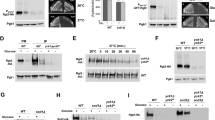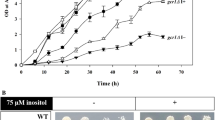Abstract
The REG1 gene encodes a regulatory subunit of the type-1 protein phosphatase (PP1) Glc7 in Saccharomyces cerevisiae, which directs the catalytic subunit to substrates involved in glucose repression. Loss of REG1 relieves glucose repression of many genes, including the MAL structural genes that encode the maltose fermentation enzymes. In this report, we explore the role of Reg1p and its homolog Reg2p in glucose-induced inactivation of maltose permease. Glucose stimulates the proteolysis of maltose permease and very rapid loss of maltose transport activity – more rapid than can be explained by loss of the permease protein alone. In a reg1Δ strain we observe a significantly reduced rate of glucose-induced proteolysis of maltose permease, and the rapid loss of maltose transport activity does not occur. Instead, surprisingly, the slow rate of proteolysis of maltose permease is accompanied by an increase in maltose transport activity. Loss of Reg2p modestly reduces the rates of both glucose-induced proteolysis of maltose permease and inactivation of maltose transport activity. Overexpression of Reg2p in a reg1Δ strain suppresses the effect on maltose permease proteolysis and partially restores the inactivation of maltose transport activity, but does not affect the insensitivity of MAL gene expression to repression by glucose observed in this strain. Thus, protein phosphatase type-1 (Glc7p-Reg1p and Glc7p-Reg2p) plays a role in transduction of the glucose signal during glucose-induced proteolysis of maltose permease, but only Glc7p-Reg1p is involved in glucose-induced inactivation of maltose transport activity and glucose repression of MAL gene expression. Overexpression of REG1 partially restores proteolysis of maltose permease in a grr1Δ strain, which lacks glucose signaling, but does not rescue rapid inactivation of maltose transport activity or sensitivity to glucose repression. A model for the role of Reg1p and Reg2p in glucose signaling pathways is discussed. We also uncovered a previously unrecognized G2/M delay in the grr1Δ but not the reg1Δ strains, and this delay is suppressed by REG1 overexpression. The G1/S delay seen in grr1Δ mutants is slightly suppressed as well, but REG1 overexpression does not suppress other grr1Δ phenotypes such as insensitivity to glucose repression.
Similar content being viewed by others
Author information
Authors and Affiliations
Additional information
Received: 21 October 1999 / Accepted: 28 December 1999
Rights and permissions
About this article
Cite this article
Jiang, H., Tatchell, K., Liu, S. et al. Protein phosphatase type-1 regulatory subunits Reg1p and Reg2p act as signal transducers in the glucose-induced inactivation of maltose permease in Saccharomyces cerevisiae . Mol Gen Genet 263, 411–422 (2000). https://doi.org/10.1007/s004380051185
Issue Date:
DOI: https://doi.org/10.1007/s004380051185




